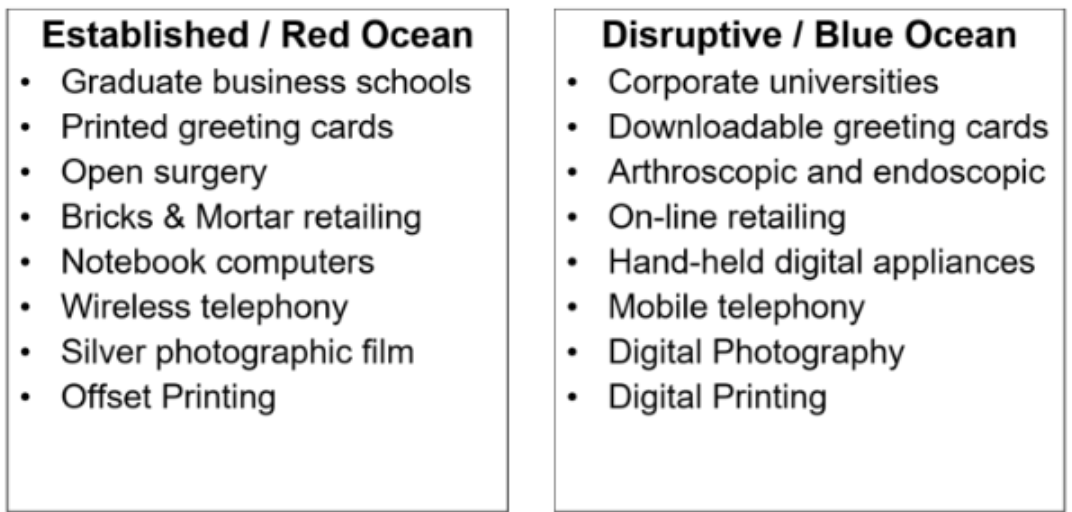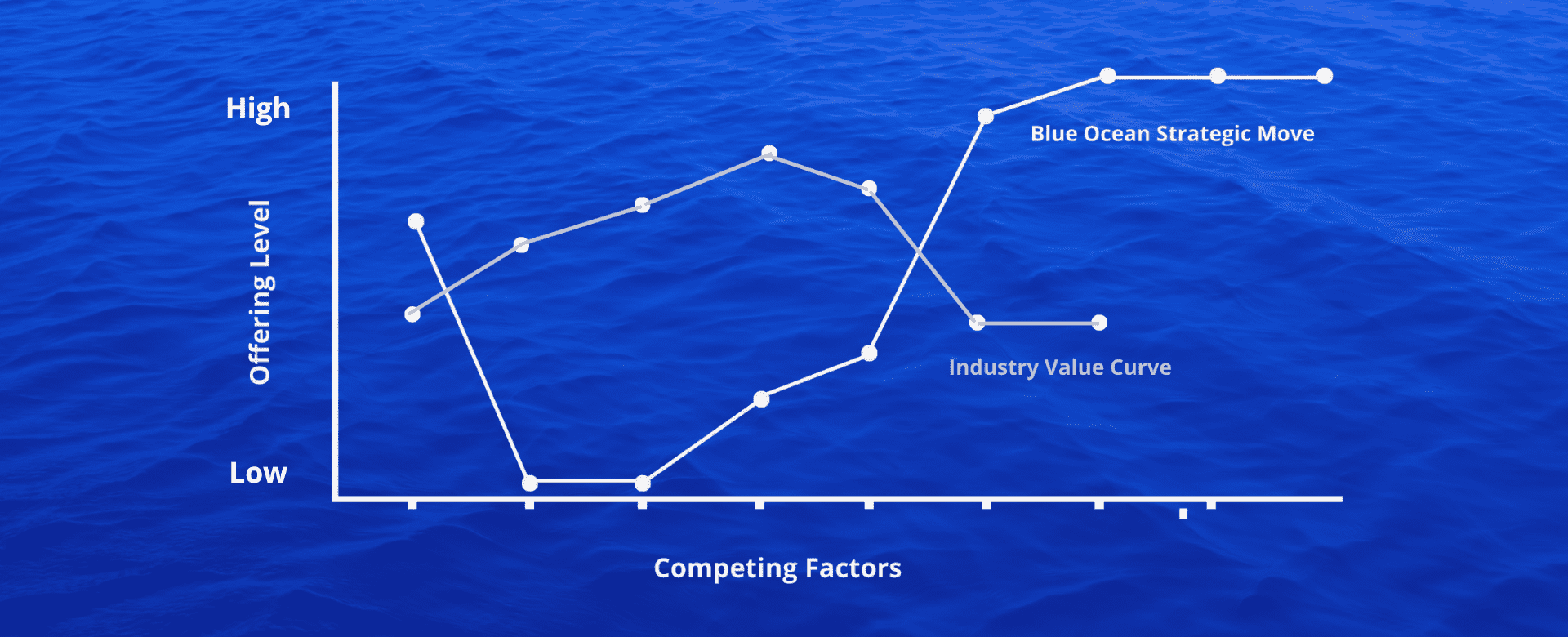Blue Ocean Positioning Strategy
Download Template
Click here to get access to this fill-in-blank template and others
Out-position your competition
Companies have two basic options when they seek to build new-growth businesses.
- They can try to take an existing market from an entrenched competitor with sustaining innovations.
- They can try and completely bypass competitors by going after the same market with a new novel idea or innovation (for example: How Henry Ford took over the transportation market by creating a car instead of making a faster horse)
Why do incumbent firms pursue sustaining rather than disruptive innovations?
They are poor managers.
The innovation process is unpredictable.
They are doing what is logical–providing a better product to their most profitable customers, leaving the least profitable customers behind.
As a new entrant to the market, you have a big advantage over incumbents by pursuing disruptive innovation.
Blue Ocean strategy
Blue ocean strategy is a methodology, it’s a way of looking at your industry, competitors, and the services you provide and determining how you can develop a product or service that provides a totally different value proposition than what currently exists in your market.
Blue Ocean strategy is all about creating disruptive innovations in your marketplace.
How Is the Blue Ocean Different?
By providing you with tools that are unlike the traditional SWOT analysis, you end up with different answers. The answers that you come up with will be new ways to approach your market offering a different value proposition that will create a new customer base for which you have no competition.
Creating Blue Oceans
There are two ways to create blue oceans.
- You can start a completely new industry, just like eBay did with online auctions. (This is much rarer.)
- You create a blue ocean from within a red ocean. You do this by changing the balance of the characteristics that create value for the customers (easier – especially with tools).

Value Innovation: The Cornerstone of Blue Ocean Strategy
It is no longer about being all things to all men. Understanding the value elements that matter and focusing on them both increase your perceived expertise in that area as well as drive costs down.
We call it 'value innovation' because instead of focusing on beating the competition, you focus on making the competition irrelevant by creating a leap in value for buyers and your company, thereby opening up new and uncontested market space.
Cirque du Soleil and Southwest Airlines understood their value elements and only focused on them, thus rendering the other market irrelevant.
Conducting a blue ocean analysis
The Strategy Canvas

The strategy canvas is a high-level depiction of current and future strategic positions based on the key Blue Ocean principles; it helps you examine value creation, value capture, and opportunity.
The Strategy Canvas:
- Graphically depicts you and your competitors, value elements (value proposition investments).
- Suggests areas of opportunity on which to escape/eliminate competition.
- Captures the current and future state of activity within a market space.
- Documents current and future competitive investment.
What is a Value Element?
Value Elements are those value-creating components a company invests in including resources, processes, and capabilities
Value Elements:
- can be derived from direct or indirect analysis of a company.
- help form the basis for value creation and value capture.
- can be used as the basis of differentiation and competition.
- are high-level graphical depictions used to communicate strategic intent.
- require a deliberate choice for the allocation of organization resources.
- change over time with the adaptation of value propositions and strategy.
Four Actions Framework
A helpful tool in crafting a future strategy canvas is the ‘Four Actions Framework’ because it helps in identifying the value elements to be created, increased, decreased, or eliminated.
Eliminate: The first question forces you to consider eliminating factors that companies in your industry have long competed on. Often those factors are taken for granted even though they no longer have value or may even detract from value. Sometimes there is a fundamental change in what buyers value, but companies that are focused on benchmarking one another do not act on, or even perceive, the change.
Reduce: The second question forces you to determine whether products or services have been overdesigned in the race to match and beat the competition. Here, companies overserve customers, increasing their cost structure for no gain.
Raise: The third question pushes you to uncover and eliminate the compromises your industry forces customers to make.Create: The fourth question helps you to discover entirely new sources of value for buyers and to create new demand and shift the strategic pricing of the industry.
Three Characteristics of a Good Strategy
The blue ocean strategy ensures you have these three elements!
- Focus: This allows all your messaging to have a core concept as well driving costs downEvery great strategy has focus, and a company’s strategic profile, or value curve, should clearly show it. Looking at Southwest’s profile, we can see at once that the company emphasizes only three factors: friendly service, speed, and frequent point-to-point departures. By focusing in this way, Southwest has been able to price against car transportation; it doesn’t make extra investments in meals, lounges, and seating choices. By contrast, Southwest’s traditional competitors invest in all the airline industry’s competitive factors, making it much more difficult for them to match Southwest’s prices. Investing across the board, these companies let their competitors’ moves set their own agendas. Costly business models result.
- Divergence: This allows companies not to fall into the “me too” strategyWhen a company’s strategy is formed reactively as it tries to keep up with the competition, it loses its uniqueness. Consider the similarities in most airlines’ meals and business-class lounges. On the strategy canvas, therefore, reactive strategists tend to share the same strategic profile. Indeed, in the case of Southwest, the value curves of the company’s competitors are virtually identical and therefore can be summarized on the strategy canvas with a single value curve.In contrast, the value curves of blue ocean strategists always stand apart. By applying the four actions of eliminating, reducing, raising, and creating, they differentiate their profiles from the industry’s average profile. Southwest, for example, pioneered point-to-point travel between midsize cities; previously, the industry operated through hub-and-spoke systems
- Compelling Tagline: With this new focus and clarity you will speak directly to buyers.A good strategy has a clear-cut and compelling tagline. “The speed of a plane at the price of a car—whenever you need it.” That’s the tagline of Southwest Airlines, or at least it could be. What could Southwest’s competitors say?Cirque du Soleil’s value curve stands apart. It has new and noncircus factors such as theme, multiple productions, refined watching environment, and artistic music and dance. These factors, entirely new creations for the circus industry, are drawn from the alternative live entertainment industry of theatre.
Need extra support?
💸 Fundraising
Hansa invests, incubates, and accelerates networks that power the future of open societies on web3. Apply for funding here
🚀 Growth
End-to-end web3 strategic and executional growth support. Results in 30 days or your money back! Learn more here
Get full access to web3 growth and fundraising playbooks.
A free subscription gets you: Access to growth & fundraising playbooks, access to a private community, digital workshops & IRL meetups around the world.